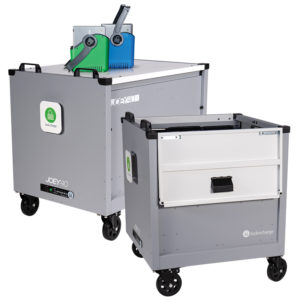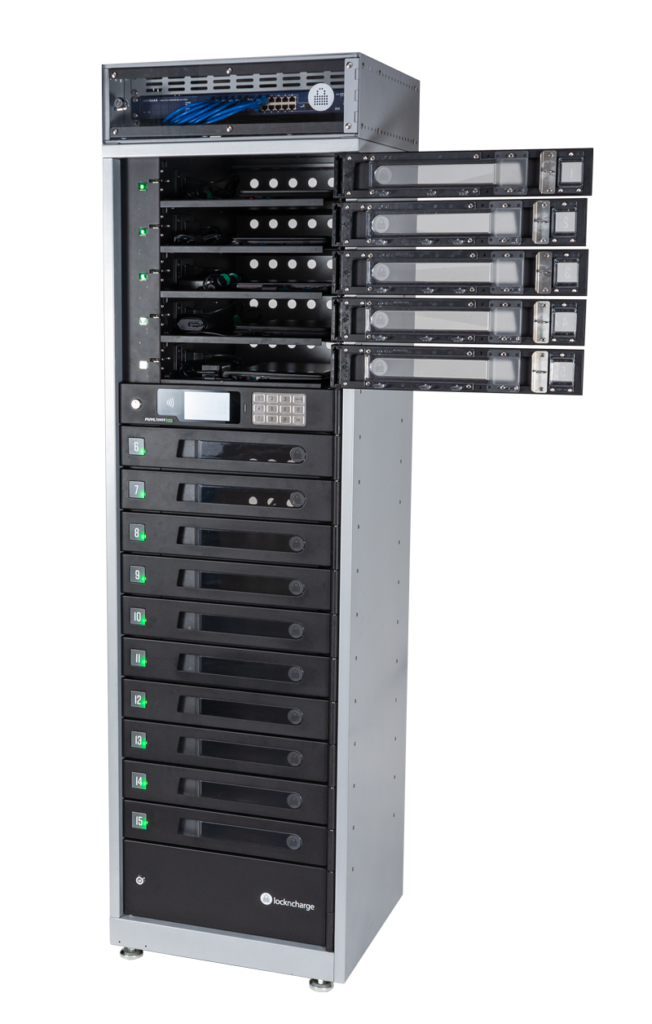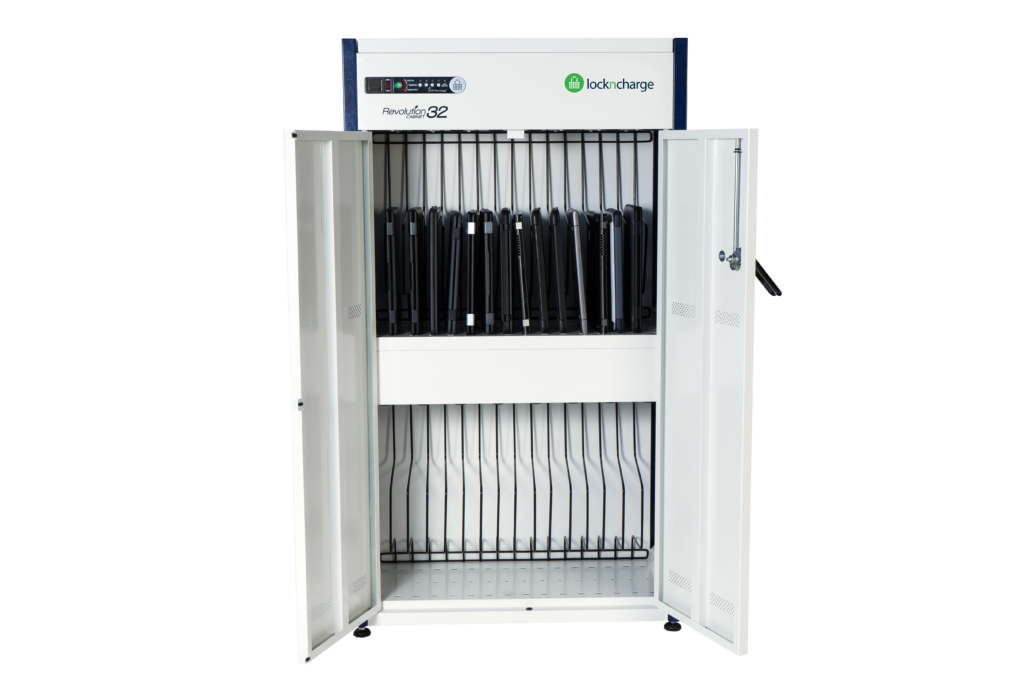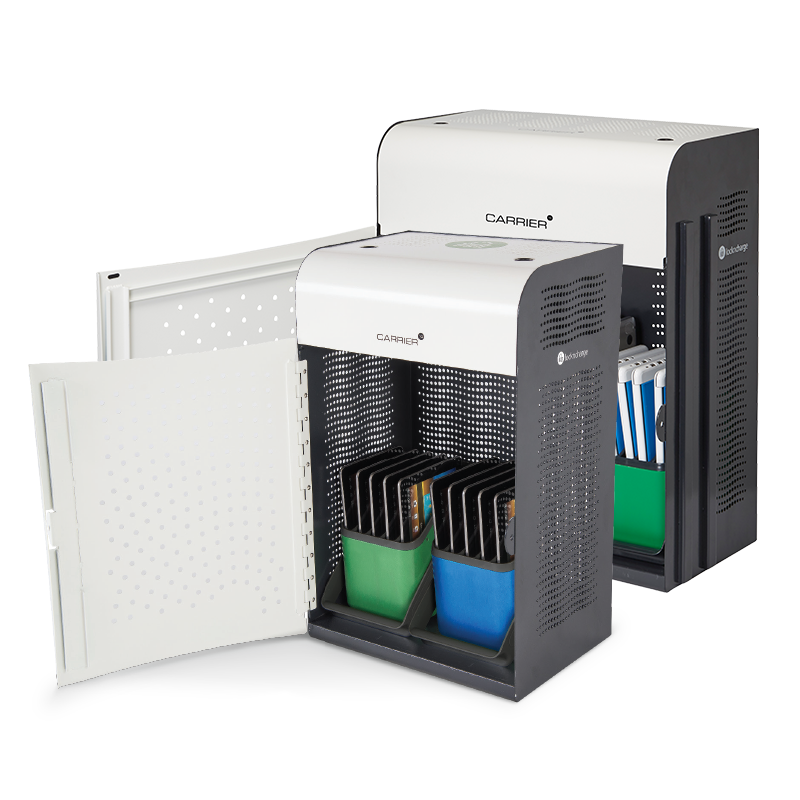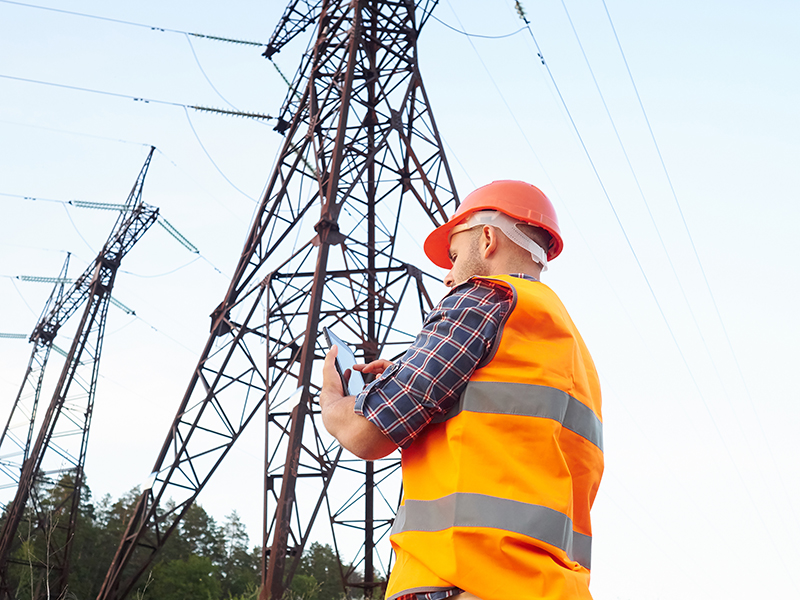The Best Charging Stations for Multiple Devices
At LocknCharge, we are dedicated to designing and manufacturing the highest quality charging stations for multiple devices for any mobile device program.
Our mission is to make life easier for schools and organizations implementing mobile device technology for multiple devices–including tablets, laptops, iPads and MacBook devices. If your school or organization has a number of devices to maintain and manage, you know how difficult it can be to find a charging solution or management system that works.
Cords can get tangled, devices become lost or stolen, a limited number of outlets can lead to a counterintuitive technology plan and device management for broken devices is compounding. With 73% of businesses failing to find a proper charging station for their technology, these problems are more common than you may think!
Best Multiple Device Charging Stations
We’ve rounded up some of our best charging stations, smart lockers and charging carts to meet the needs of multiple device types.
1. Joey Charging Carts
Affordability meets functionality.
Our Joey Carts are an affordable option for any school or business looking to charge multiple devices. The design of this Cart accommodates both racks and Baskets so you can charge up to 30 or 40 of just about any device with a 17” screen size.
Not only is the cart small and compact in size, but it also takes only minutes to wire the entire Cart. Plus the power strips are now more easily accessible, so you no longer have to wrestle with tangled cords. There’s plenty to love about this cart! Check it out here.
2. FUYL Smart Locker System
The FUYL Smart Locker System takes hardware asset management to the next level.
The FUYL Smart Charging Locker System is an Intelligent Hardware Asset Management System that charges, stores, secures and manages assets for most mobile devices in 15 individually-lockable compartments. FUYL Towers are powered by LocknCharge Cloud to remotely manage physical assets secured inside the Tower.
This smart charging locker has 5 or 15 individually-lockable compartments, each equipped with a power outlet and a 2.4 amp USB port. You can manage almost any device, including iPads, tablets, laptops, mobile phones, Chromebooks and more. Learn more about the FUYL Smart Locker System here.
3. Carrier Charging Carts
Carrier 20, 30 and 40 Carts provide ultimate security and durability.
Secure, efficient and a future-proofed, Carrier 20, 30 and 40 Carts sound almost too good to be true, right? Well, these Carts live up to the task. With the option for either racks or baskets, Carrier Carts accommodate almost any device up to 17”. Remove the racks or baskets to create an open-concept design that can also hold other technology such as robotics, printers, drones and more.
Our Baskets by LocknCharge hold five devices and make device deployment quick and easy. The top-loading design ensures easy access to devices–no more bending down to gather devices on a bottom shelf. And with cabling stored in the bottom of the Cart, power bricks and cords stay organized and will never go missing. Learn more about Carrier Carts here.
4. Revolution 32 Charging Cabinet
Charge a greater number of devices in a small footprint.
This charging cabinet can accommodate 32 devices up to 17 inches, with or without a case while taking up 50% less floor space than a traditional charging cart.
For 1:1 classrooms that are tight on space but need to charge, store and secure a greater amount of devices, the Revolution 32 Charging Cabinet is just the ticket. And with ECO Safe Charge Power Management, you can easily charge 32 devices in the same amount of time as just one. Learn more here.
5. Carrier Charging Stations
Carrying you to better charging solutions, one station at a time.
Limited on space? No worries - with our Carrier Charging Stations, you can make any wall or desk a secure charging station for anywhere from 10 to 15 devices.
This charging station for multiple devices also comes equipped with Baskets, making deployment of devices up to 13” faster and easier. And for devices up to 17”, swap the Baskets for Racks to easily accommodate larger devices. Still not convinced? Charge your devices while they’re safely locked, giving you back classroom and work time. Check out the station here.
PD Charging 101 – Everything You Need to Know About PD Charging
Commonly Asked Power Delivery (PD) Questions
Mobile device charging technology has come a long way in the past few years. The PD Charging standard and the Type C connector were developed in tandem with the aim of being as universal as possible, making mobile device charging fast and more efficient. As the experts in physical device management, we've answered some of the most commonly asked questions about PD (Power Delivery) charging to help you better understand what it is, how it works and how it may benefit your organization.
Power Delivery (PD) Charging is the latest mobile device charging standard. It lets us quickly charge larger capacity batteries than we were able to in the past. Phones, tablets and laptops can all use PD Charging.
A USB-C PD Charger can detect the device it’s connected to. If that device supports PD protocol, it will negotiate/communicate between the charger and device, and it will send the right amount of power to provide the fastest charge possible.
Together, PD Charging standard and Type C connector are the dream team! The PD Charging standard and the Type C connector were developed in tandem with the aim being as universal as possible.
Lightning devices like the iPhone 12, iPhone X and various iPads have been PD compatible for some time. Using a PD charger in conjunction with an MFI-certified Type-C to Lightning cable allows for higher current draw and faster charging.
Type C is much more than just a cable connector or a device socket. There’s a standard for the connector and socket, several standards for the charging method and yet more standards for the communication of data. Just because a device has a Type C socket does not necessarily mean it also supports PD or high-speed data.
Voltage is selected by negotiation/communication between the charger and the device.
iPhone 12, iPhone X, iPhone 8/ 8 Plus, iPad Pro, Google Pixel 5, Google Pixel 2, Google Pixel 2 XL, Samsung S20 and Note are just some of the popular devices that use PD. When investing in new hardware it’s important to know your new devices are fully compatible with the supporting hardware.
Varies on a product basis. Check your device for specifics.
This is a broader question than people realize. Your old charger can take a USB-A to Type C cable which can connect to a Type C port on a new device and in some cases, may work. So, if you already have the charger and the cable there’s no harm in trying it out.
But most devices will not charge properly, and some will not charge at all. This is important to remember when investing in new hardware.
The Watt capacity (Wattage) of a charger is the amount of power a charger can supply to a device that requests it. Note it is the devices prerogative to request that charge.
The Wattage of a deceive is the amount of power a device can source from a suitable charger.
There is no danger to either device of charger if the relative wattages do not match.
It is ideal for the device (in terms of charge time) that the charger Wattage matches or exceeds the Wattage of the device.
If the attached device does not support the PD protocol, communication cannot be established. By default, a lower charge rate is used. The short of this being that it may just take longer to charge than normal.
Best Charging Stations with USB-C PD
Best Smart Charging Lockers with USB-C PD
How Mobile Devices Help Field Reps Provide Better Service
You may think of a Field Rep as someone who works for a utility company and comes to your house to service your cable box. However, Field Reps are common in many other industries; think mechanics, roadside vehicle service providers, public transportation agents, logistics operations and quality control/maintenance teams.
When Field Reps carry mobile devices, their lines of information and communication drastically open up in many ways. Mobile devices such as tablets and phones are now affording mobile employees a variety of benefits.
Benefits of Mobile Devices for Field Services
Instant Research and Information
Mobile devices give Field Reps access to a world’s worth of research on the go. They can gain insight into their customers and future leads, reflecting better on their company. Additionally, Field Reps working for organizations like energy companies and cable companies will be able to pull up important customer account information at the drop of a hat. Inventory, warranties, and numerous other documents can be at their fingertips. They won’t need to contact their call center, and their customers won’t need to dredge up paperwork.
Information Gathering
With a mobile device, Field Reps can quickly input or update a customers email address, phone number and other data. This also allows for fast follow-ups. Mobile employees such as roadside vehicle service providers can send a quick email or make a call from a mobile device. As companies grow and start to become more data savvy, Field Reps are gathering more data on their customers every time they meet, which allows companies to provide even better customer service.
Real-time data collection is extremely useful to companies because it provides up-to-date information that can be shared throughout an entire organization in seconds. Energy and utility company reps, for example, are able to record meter readings, upload photos of the assessed damage, etc. effortlessly and seamlessly. Real-time data entry ensures that information is recorded more efficiently and more accurately.
GPS
When mobile devices are equipped with location services, customers can know almost exactly when their Field Rep will show up. The mobile device can send a ping to the customer when the Field Rep is on their way, so they will always feel prepared and have a more accurate time estimate. On the other side, Field Reps will be able to more quickly and accurately find the place they’re going with simple GPS capabilities. Imagine if all quality control and maintenance teams used this method.
Instant, Real-Time Communication
Customers and mobile employees can communicate seamlessly–imagine customers never having to phone into a call center to be connected to their rep. If customers can connect directly with their field rep through text, chat or another messaging service, they will be impressed with their reps’ fast response times.
Tips for Efficiently Managing Mobile Devices for Field Service Reps
When you equip your Field Reps with mobile devices, it’s crucial to keep them secure and charged up. Businesses use LocknCharge charging stations or smart charging lockers to save time and money. Here are some quick tips to optimize efficiency for your field service reps:
Store and charge laptop, tablet or cell phone devices in a centralized location.
Centralized device charging sets your reps up for success by ensuring devices are charged, easy to access and ready for use at all times.
Secure devices when not in use.
Would it surprise you to learn that 41% of data breaches are due to lost or stolen devices? Because critical company and customer data is often stored on employee devices, it's important to keep them physically secure after use. Securing devices also helps reduce device breakage to save organizations money on replacement hardware.
Automate your daily device check in/out process.
Field Reps can check out a charged device at the beginning of a shift, spend the day on service calls using a device, and return the device at the end of the shift. With a Cloud-Connected Smart Locker, all of this can be facilitated without manager oversight.
Hold device users accountable.
A FUYL Tower Charging Locker powered by LocknCharge Cloud helps to ensure devices are cared for during use and properly returned after use. By tracking who accessed a bay and when it was accessed, device users are held to account. Remote visibility into the Cloud portal allows department managers or tech teams to see who took a device, when it was taken and when it was returned.
Ready to find out more?
Drop us a line today for a free quote!
5 Best iPad Charging Stations and Carts for Classrooms & Businesses
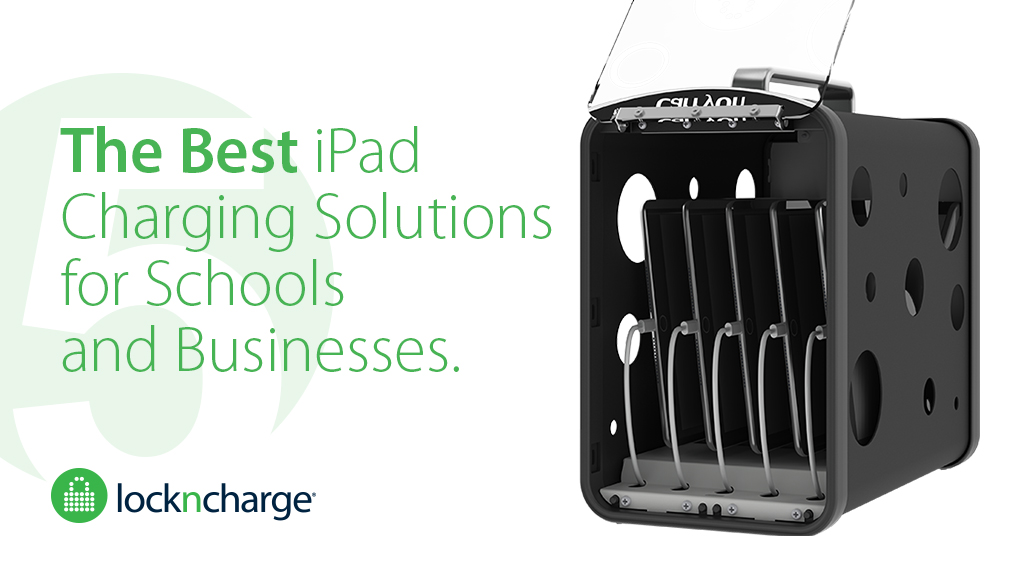
If your organization owns iPads for students or staff to complete their work, then you need a simple (and secure) way to store, charge, and distribute the devices. A high-quality storage system like an iPad classroom charging station or an iPad charging cart can solve this need.
Nothing hinders learning like grabbing an iPad, only to find that it isn’t fully charged. A high-quality iPad classroom charging station or cart lets your school safely store and charge iPads and transport them from one classroom to another.
When it comes to productivity in a business setting, an uncharged iPad device can have serious downstream consequences. Consider cost of the employee's downtime as well as a potential a lost sale due to a device that isn't working when needed.
Choosing the best iPad cart or best iPad charging station for your school or business depends on many factors, such as how many iPads you need to store at once and if device portability is important to your workflow.
At LocknCharge, we make iPad charging carts for schools and businesses as well as iPad classroom charging stations or office charging stations to meet a wide variety of needs.
5 Best iPad Charging Station Solutions for Schools and Businesses
1. iQ 10 Charging Station
- Compatibility: iPad and tablet devices
- Capacity: 10 devices
The iQ 10 Charging Station with USB-C PD lets you quickly charge, store, and secure up to 10 iPad, iPad Air, iPad Mini, or other tablet devices in a compact unit that can be mounted on a desk or wall.
A feature that is unique to LocknCharge iPad carts and charging stations is that the devices are stored in baskets of five devices each, making device distribution easy for teachers and students.
Welded steel construction and a hardened steel padlock protect your iPad devices while they’re not in use, and the product comes with a lifetime warranty.
2. Putnam Charging Station
- Compatibility: iPad, tablet or cell phone devices
- Capacity: 8 or 16 devices
Designed to charge, store, and secure up to 8 or 16 iPads or tablets, the Putnam Charging Station with USB-C PD is a wall-mounted or stackable charging locker that features color-coded LED displays so you know when your devices are charged.
The Putnam Charging Station comes equipped with 8 or 16 USB-C cables that are sized to the perfect length for quickly plugging in devices after use. Cables are also integrated into the station so they don't sprout legs and wander off.
Welded steel construction makes the unit ultra secure, and it comes with a robust warranty. A built-in mechanical combination lock means there are no keys to worry about, and a master override key is included in case the combination is forgotten.
3. Joey Charging Cart
- Compatibility: iPad, tablet, MacBook or laptop devices
- Capacity: 30 devices
The Joey 30 or 40 Carts is one of our most popular universal charging cart solutions for tablets and laptops. The open concept design can accommodate a wide variety of devices, including iPad, iPad Pro or MacBook devices. The Joey Charging Cart features access to up to 30 devices from the top, with a "tool box" tray that lifts out so cables are accessible when needed. It also comes with Large baskets by LocknCharge for easy device distribution.
4. Carrier Charging Stations
- Compatibility: iPad, tablet, MacBook or laptop devices
- Capacity: 10 or 15 devices
Carrier Charging Stations lets you charge, store and secure 10 or 15 of almost any device including iPads, iPad Pros, and MacBooks. Removable baskets can be swapped with wire racks to accommodate devices up to 17″. The steel construction and heavy-duty lock make this charging station ultra secure.
The Carrier iPad Charging Station can easily be mounted to the wall, taking up minimal space. And since the cables and bricks are stored in a separate compartment, you’ll never need to worry about missing or tangled cords.
5. CarryOn Portable Charging Station
- Compatibility: iPad and tablet devices
- Capacity: 5 devices
The first iPad cart or charging station designed to be ultra-portable, the CarryOn with USB-C PD allows you to quickly charge, store, and transport up to five iPad or tablet devices using a sleek carrier the size of a briefcase.
The CarryOn can store tablets with screen sizes up to 10 inches, with or without cases. Its aluminum outer shell makes it both lightweight (5.5 pounds) and durable, protecting the devices inside. The transparent acrylic door lets you quickly see that all devices are there, while the impact-resistant alloy edging gives it a classy look. The CarryOn’s door includes a keyed lock to keep devices safe, and a wall mount kit lets you use it as a cabinet as well.
Best Mobile Device Charging Stations for Schools
The past few years have tested many school districts like never before, but within what sometimes seemed like chaos, opportunities emerged. Both remote learning programs and mobile device programs skyrocketed, and along with them, the need for secure, reliable mobile device charging stations.
Schools quickly learned that there are many options for deploying mobile devices—and that each model comes with its own set of device management challenges. Choosing what makes the most sense for your district can be hard.
Do you want to give every student a digital device to take home? Provide students with devices that stay in each classroom? Distribute mobile devices to students through a shared cart approach? Or let students bring their own devices from home?
The way you store, charge and manage devices will depend on the model you choose for deploying mobile devices to students. Read on to learn the pros and cons of the best mobile device charging stations for schools.
1:1 Programs - Devices Stay in the Classroom
Benefits: This model creates consistency and uniformity, making it easier for IT staff to support the devices. Because everyone is using the same type of device with the same platform, teachers know that whatever apps they use will work on students’ devices. And since the devices remain at school, teachers don’t have to worry about students leaving their devices at home or forgetting to charge them. It’s also the smartest investment for schools on a tight budget.
Challenges: When students leave devices at school, they’re not able to use them for homework. This type of program also doesn't allow for distance learning, should schools ever close again in the future.
Best Mobile Device Charging Stations
Because devices don’t need to be moved from one classroom to another in a full 1:1 environment, a wall charging station is a fitting option. These units take up less space and typically cost less than a cart, leaving more money to spend on other tech tools.
When you’re distributing devices to students at the start of class each day, time is at a premium. The best charging stations for schools make this process much easier and more efficient, which saves valuable class time for instruction. That’s why we created the unique basket design of our Carrier 10 and 15 and iQ 10 with USB-C PD charging stations.
Another option is the Putnam 8 or 16 with USB-C PD. While these aren’t basket-compatible, they are perfect for 1:1 “stay at school” programs that use tablets. As an added bonus, the station’s external LED display makes it easy to know if all devices have been put away at the end of the day, and they come pre-wired with USB-C cables, making setup a breeze.
1:1 Programs - Students Take Devices Home
Benefits: Letting students take school-owned devices home creates a “classroom without walls,” enabling 24-7 learning. It also addresses the digital divide and the so-called “homework gap,” ensuring that all students have equitable access to learning opportunities and their teachers.
Challenges: Besides the obvious funding hurdles, take-home 1:1 programs come with an increased risk of devices being damaged, lost or stolen. It can be harder for schools to manage the devices, as students might be downloading apps or using devices in unintended ways. What’s more, students might forget to charge their device or forget to bring their device altogether. Another challenge that often comes up is how to store and charge devices over the summer when all of the devices are returned to school.
Best Mobile Device Charging Stations
An excellent solution is the FUYL Smart Locker System Smart Locker, which includes 5 or 15 individually-lockable compartments that can store and charge any mobile device. Many schools are placing FUYL Smart Lockers in common spaces or media centers so that students can securely charge their devices between classes, during classes that don’t require the use of a mobile device or during lunch. The individually lockable compartments work like a hotel safe, creating less work for educators because students can manage their devices at school without any assistance.
Some schools are also using FUYL Smart Locker System for device “loaner” programs or break/fix programs. In these scenarios, they’re fully stocking a Smart Locker with extra devices so that if a device is broken, or if a student forgets to bring his device from home, the student can be given a PIN to retrieve a loaner device without IT staff having to intervene. They have also been extremely useful in distributing devices to students or teachers during distance learning.
Another option is to install secure charging stations for schools to help make sure a dead battery doesn’t disrupt learning. The Carrier Charging Station or iQ Charging Station can be easily mounted to a wall in a library or classroom, and both take up only minimal space.
Shared Device Environments
Benefits: Having classrooms share devices allows schools to keep costs down and extend their resources further. A shared-use environment can be much less expensive than a full 1:1 program, and with fewer devices to support, IT staff aren’t as stretched thin. Shared carts are also great for specialized or expensive equipment, like the devices used for STEM or gaming programs.
Challenges: Teachers have to schedule their use of carts and mobile device charging stations, and students won’t have daily access to the devices for learning. These factors may discourage teachers from using technology for instruction. In addition, the apps that students use for learning will vary from one classroom to the next, so teachers will need an easy way to set up and customize shared devices for their students.
Best Mobile Device Charging Stations
Our Carrier Charging Carts and Joey Charging Carts easily travel from classroom to classroom, and they include our innovative device distribution baskets. These baskets, along with the top-loading design of the carts, cut the time it takes to distribute and collect devices in half. What’s more, teachers can use the baskets themselves to transport devices between classrooms safely and efficiently, or they can enlist the help of students.
Bring Your Own Device (BYOD) Programs
Benefits: BYOD programs are the least expensive way to use technology for teaching and learning because schools can leverage the devices students already own. What’s more, students are already comfortable with their own device, so there’s no learning curve associated with the technology.
Challenges: Teaching in a mixed-device environment can be difficult. Teachers have to make sure the learning materials they use are accessible across a wide range of platforms. There is more potential for distraction because devices contain personal apps, and variations in the age, speed, and processing power of devices—or a lack of resources to purchase their own device at all—could lead to inequities in how students learn.
Best Mobile Device Charging Stations
Even though students are bringing their own devices from home, you’ll still need secure charging stations for schools. A solution that can store and charge a wide variety of device types—such as the FUYL Smart Locker System, which contains 5 or 15 individually-lockable compartments—is ideal.
Students will find any outlet they can to charge their devices during the school day, often leaving them unattended. FUYL Smart Lockers significantly cut back on missing or stolen devices because students don’t have to leave their device out in the open while charging. FUYL Smart Locker Systems are also extremely flexible. They have two modes, which allows you to facilitate a break/fix program or loaner device program as well as public charging.
While the best mobile device charging stations, charging carts and smart lockers for your school or district depends on the type of program you implement, LocknCharge has a variety of solutions to fit all needs. Contact us today and we’ll work with you to find your perfect charging solution.
